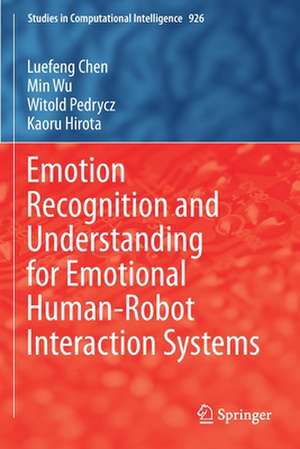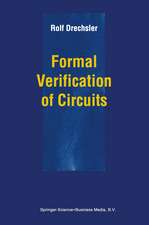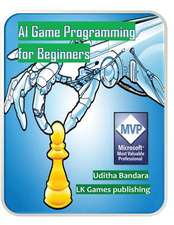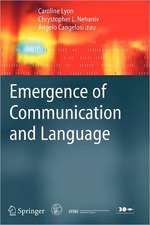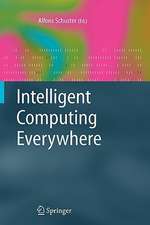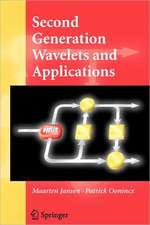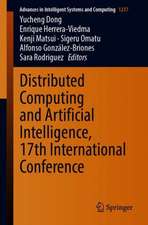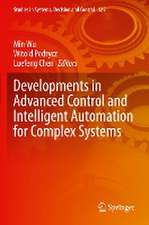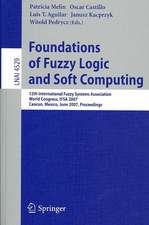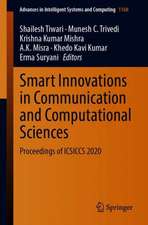Emotion Recognition and Understanding for Emotional Human-Robot Interaction Systems: Studies in Computational Intelligence, cartea 926
Autor Luefeng Chen, Min Wu, Witold Pedrycz, Kaoru Hirotaen Limba Engleză Paperback – 14 noi 2021
| Toate formatele și edițiile | Preț | Express |
|---|---|---|
| Paperback (1) | 986.94 lei 39-44 zile | |
| Springer International Publishing – 14 noi 2021 | 986.94 lei 39-44 zile | |
| Hardback (1) | 1162.37 lei 6-8 săpt. | |
| Springer International Publishing – 14 noi 2020 | 1162.37 lei 6-8 săpt. |
Din seria Studies in Computational Intelligence
- 20%
 Preț: 449.37 lei
Preț: 449.37 lei - 20%
 Preț: 1158.26 lei
Preț: 1158.26 lei - 20%
 Preț: 986.66 lei
Preț: 986.66 lei - 20%
 Preț: 1452.76 lei
Preț: 1452.76 lei - 20%
 Preț: 168.78 lei
Preț: 168.78 lei - 18%
 Preț: 1112.30 lei
Preț: 1112.30 lei - 20%
 Preț: 565.38 lei
Preț: 565.38 lei - 20%
 Preț: 649.28 lei
Preț: 649.28 lei - 20%
 Preț: 1047.73 lei
Preț: 1047.73 lei - 20%
 Preț: 1578.96 lei
Preț: 1578.96 lei - 20%
 Preț: 643.50 lei
Preț: 643.50 lei - 20%
 Preț: 657.49 lei
Preț: 657.49 lei - 20%
 Preț: 993.28 lei
Preț: 993.28 lei - 20%
 Preț: 990.80 lei
Preț: 990.80 lei - 20%
 Preț: 989.96 lei
Preț: 989.96 lei - 20%
 Preț: 1165.69 lei
Preț: 1165.69 lei - 20%
 Preț: 1444.52 lei
Preț: 1444.52 lei - 20%
 Preț: 1041.96 lei
Preț: 1041.96 lei - 20%
 Preț: 1047.73 lei
Preț: 1047.73 lei - 20%
 Preț: 1046.06 lei
Preț: 1046.06 lei - 18%
 Preț: 2500.50 lei
Preț: 2500.50 lei - 20%
 Preț: 989.13 lei
Preț: 989.13 lei - 20%
 Preț: 1165.69 lei
Preț: 1165.69 lei - 20%
 Preț: 1164.05 lei
Preț: 1164.05 lei - 20%
 Preț: 1042.79 lei
Preț: 1042.79 lei - 20%
 Preț: 1460.19 lei
Preț: 1460.19 lei - 18%
 Preț: 1403.52 lei
Preț: 1403.52 lei - 18%
 Preț: 1124.92 lei
Preț: 1124.92 lei - 20%
 Preț: 1039.47 lei
Preț: 1039.47 lei - 20%
 Preț: 1008.11 lei
Preț: 1008.11 lei - 20%
 Preț: 1045.25 lei
Preț: 1045.25 lei - 20%
 Preț: 1275.42 lei
Preț: 1275.42 lei - 20%
 Preț: 1040.32 lei
Preț: 1040.32 lei - 20%
 Preț: 988.32 lei
Preț: 988.32 lei - 20%
 Preț: 1169.79 lei
Preț: 1169.79 lei - 20%
 Preț: 1162.37 lei
Preț: 1162.37 lei - 20%
 Preț: 1059.26 lei
Preț: 1059.26 lei - 20%
 Preț: 1164.05 lei
Preț: 1164.05 lei - 20%
 Preț: 1166.52 lei
Preț: 1166.52 lei - 20%
 Preț: 1459.38 lei
Preț: 1459.38 lei - 18%
 Preț: 1005.74 lei
Preț: 1005.74 lei - 20%
 Preț: 997.38 lei
Preț: 997.38 lei - 20%
 Preț: 1055.94 lei
Preț: 1055.94 lei - 20%
 Preț: 1284.47 lei
Preț: 1284.47 lei - 20%
 Preț: 994.08 lei
Preț: 994.08 lei - 20%
 Preț: 1048.72 lei
Preț: 1048.72 lei - 20%
 Preț: 1066.02 lei
Preț: 1066.02 lei - 20%
 Preț: 943.78 lei
Preț: 943.78 lei - 20%
 Preț: 1173.10 lei
Preț: 1173.10 lei - 20%
 Preț: 1457.72 lei
Preț: 1457.72 lei
Preț: 986.94 lei
Preț vechi: 1233.68 lei
-20% Nou
Puncte Express: 1480
Preț estimativ în valută:
188.87€ • 196.94$ • 156.97£
188.87€ • 196.94$ • 156.97£
Carte tipărită la comandă
Livrare economică 17-22 martie
Preluare comenzi: 021 569.72.76
Specificații
ISBN-13: 9783030615796
ISBN-10: 3030615790
Pagini: 247
Ilustrații: XI, 247 p. 130 illus., 85 illus. in color.
Dimensiuni: 155 x 235 mm
Greutate: 0.37 kg
Ediția:1st ed. 2021
Editura: Springer International Publishing
Colecția Springer
Seria Studies in Computational Intelligence
Locul publicării:Cham, Switzerland
ISBN-10: 3030615790
Pagini: 247
Ilustrații: XI, 247 p. 130 illus., 85 illus. in color.
Dimensiuni: 155 x 235 mm
Greutate: 0.37 kg
Ediția:1st ed. 2021
Editura: Springer International Publishing
Colecția Springer
Seria Studies in Computational Intelligence
Locul publicării:Cham, Switzerland
Cuprins
Introduction.- Multi-modal emotion feature extraction.- Deep sparse autoencoder network for facial emotion recognition.- AdaBoost-knn with direct optimization for dynamic emotion recognition.- Weight-adapted convolution neural network for facial expression recognition.- Two-layer fuzzy multiple random forest for speech emotion recognition.- Two-stage fuzzy fusion based-convolution neural network for dynamic emotion recognition.- Multi-support vector machine based Dempster-Shafer theory for gesture intention understanding.- Three-layer weighted fuzzy support vector regressions for emotional intention understanding.- Dynamic emotion understanding based on two-layer fuzzy fuzzy support vector regression-Takagi-Sugeno model.- Emotion-age-gender-nationality based intention understanding using two-layer fuzzy support vector regression.- Emotional human-robot interaction systems.- Experiments and applications of emotional human-robot.
Textul de pe ultima copertă
This book focuses on the key technologies and scientific problems involved in emotional robot systems, such as multimodal emotion recognition (i.e., facial expression/speech/gesture and their multimodal emotion recognition) and emotion intention understanding, and presents the design and application examples of emotional HRI systems. Aiming at the development needs of emotional robots and emotional human–robot interaction (HRI) systems, this book introduces basic concepts, system architecture, and system functions of affective computing and emotional robot systems. With the professionalism of this book, it serves as a useful reference for engineers in affective computing, and graduate students interested in emotion recognition and intention understanding. This book offers the latest approaches to this active research area. It provides readers with the state-of-the-art methods of multimodal emotion recognition, intention understanding, and application examples of emotional HRI systems.
Caracteristici
Provides a comprehensive and up-to-date treatise of the area of emotion recognition and understanding by exposing a spectrum of methodological and algorithmic issues Discusses implementations and case studies, identifying the best design practices Assesses business models and practices of the methodology of emotion recognition and understanding as encountered nowadays in emotion robot systems Offers some introductory chapters on the paradigm of emotion recognition and understanding for emotion robot systems so that the book is made self-contained and easily accessible
